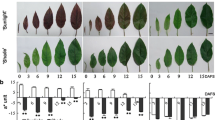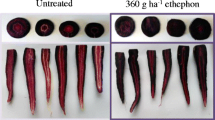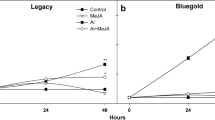Abstract
Red, purple, and blue sepals on selected cultivars of Hydrangea macrophylla were analyzed for their aluminum content. This content was determined to be a function of the sepal color with red sepals possessing 0–10 μg Al/g fresh sepal, purple sepals having 10–40 μg Al/g fresh sepal, and blue sepals containing greater than 40 μg Al/g fresh sepal. Accordingly, the threshold aluminum content needed to change H. macrophylla sepals from red to blue was about 40 μg Al/g fresh sepal. Higher aluminum concentrations were incorporated into the sepals, but this additional aluminum did not affect the intensity or hue of the blue color. These observations agreed with a chemical model proposing that the concentration of the blue Al3+-anthocyanin complex reached a maximum when a sufficient excess of aluminum was present. In addition, the visible absorbance spectra of harvested red, purple, and blue sepals were duplicated by Al3+ and anthocyanin (delphinidin-3-glucoside) mixtures in this model chemical system.














Similar content being viewed by others
References
Allen R (1943) Influence of aluminum on the flower color of Hydrangea macrophylla. Contrib Boyce Thompson Inst 13:221–242
Asen S, Stuart NW, Siegelman HW (1959) Effect of various concentrations of nitrogen, phosphorus, and potassium on sepal color of Hydrangea macrophylla. Proc Am Soc Hort Sci 73:495–501
Asen S, Stuart NW, Specht AW (1960) Color of Hydrangea macrophylla sepals as influenced by the carry-over effects from summer applications of nitrogen, phosphorus, and potassium. Proc Am Soc Hort Sci 76:631–636
Bir R (2007) Big flowered bigleaf hydrangeas. Great Plants (Special Issue of Fine Gardening) Spring 2007:78–83
Dirr MA (2004) Hydrangeas for American gardens. Timber Press, Portland, OR
Ito D, Shinkai Y, Kato Y, Kondo T, Yoshida K (2009) Chemical studies on different color development in blue- and red-colored sepal cells of Hydrangea macrophylla. Biosci Biotechnol Biochem 73:1054–1059
Ma JF, Hiradate S, Nomoto K, Iwashita T, Matsumoto H (1997) Internal detoxification mechanism of Al in hydrangea: identification of Al form in leaves. Plant Physiol 113:1033–1039
Ma JF, Ryan PR, Delhaize E (2001) Aluminum tolerance in plants and the complexing role of organic acids. Trends Plant Sci 6:273–278
Naumann A, Horst WJ (2003) Effect of aluminum supply on aluminum uptake, translocation, and blueing of Hydrangea macrophylla (Thunb.) ser. Cultivars in a peat-clay substrate. J Hort Sci Biotechnol 76:463–469
Schreiber HD, Wade NA (2007) Field-portable analysis of anthocyanin concentration in sepals of Hydrangea macrophylla. HortSci 42:1323–1325
Schreiber HD, Swink AM, Godsey TD (2010) The chemical mechanism for Al3+ complexing with delphinidin: a model for the bluing of hydrangea sepals. J Inorg Biochem 104:732–739
Schreiber HD, Wade SE, Mayhew KM, Cobb JA (2011) Characterization of Hydrangea macrophylla cultivars by the anthocyanin content of their sepals. J Environ Hort (in press)
Takeda K, Kariuda M, Itoi H (1985) Blueing of sepal color of Hydrangea macrophylla. Phytochem 24:2251–2254
Toyama-Kato Y, Yoshida K, Fujimori E, Haraguchi H, Shimizu Y, Kondo T (2003) Analysis of metal elements of hydrangea sepals at various growing stages by ICP-AES. Biochem Eng J 14:237–241
Yoshida K, Toyama-Kato Y, Kameda K, Kondo T (2003) Sepal color variation of Hydrangea macrophylla and vacuolar pH measured with a proton-selective microelectrode. Plant Cell Physiol 44:262–268
Yoshida K, Mori M, Kondo T (2009) Blue flower color development by anthocyanins: from chemical structure to cell physiology. Nat Prod Rep 26:857–964
Acknowledgments
This research was supported by the Thomas F. and Kate Miller Jeffers Memorial Trust, Virginia Military Institute, and BackCountry Research. Samantha Wade and Taylor Godsey provided technical aid for the completion of this research.
Author information
Authors and Affiliations
Corresponding author
Rights and permissions
About this article
Cite this article
Schreiber, H.D., Jones, A.H., Lariviere, C.M. et al. Role of aluminum in red-to-blue color changes in Hydrangea macrophylla sepals. Biometals 24, 1005–1015 (2011). https://doi.org/10.1007/s10534-011-9458-x
Received:
Accepted:
Published:
Issue Date:
DOI: https://doi.org/10.1007/s10534-011-9458-x




